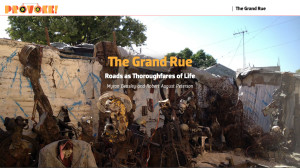The Grand Rue is a city symphony of sounds featuring audio collected three days before the devastating 2010 earthquake in Port-Au-Prince, Haiti. The project was supported by the John Hope Franklin Humanitites Institute at Duke University as part of the PROVOKE! project which is a digital collection that mixes sound studies, digital humanities, and audio arts.
Listen here to The Grand Rue: Roads as Thoroughfares of Life
Their story begins on ground level, with footsteps. They are myriad, but do not compose a series. They cannot be counted because each unit has a qualitative character: a style of tactile apprehension and kinesthetic appropriation. Their swarming mass is an innumerable collection of singularities. Their intertwined paths give their shape to spaces. They weave places together. In that respect, pedestrian movements form one of these “real systems whose existence in fact makes up the city.” They are not localized; it is rather they that spatialize. – Michel De Certeau
The Grand Rue is a road that goes through the center of Port-Au-Prince. On the official map of the city the name Grand Rue does not appear, rather inscribed in its place is Blvd. Jn. Jacques Dessalines, the name of the great leader of the slave rebellion and later self-proclaimed emperor of Haiti. But to all who reside on the island, this road, this major thoroughfare and the community of which it surrounds is referred to simply as the Grand Rue. Perhaps it is called Grand Rue because of its expansive length as it protrudes through the busy conurbation linking various neighborhoods with commerce. The true width of the street is disguised for the spillage of people and cars pushing their way through the bustling boulevard. The narrow sidewalks are claimed by street vendors selling everything from lumber and automobile fragments, to fresh fruits and freshly fried goat from cooks hovering over piping hot cauldron of oil. The “Grand Rue” is a city symphony, a composition of sounds from a complete day on this major thoroughfare that demonstrates that roads can “become liberated spaces that can be occupied,” as de Certeau puts it.
